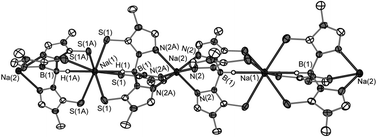The versatile behaviour of a novel Janus scorpionate ligand towards sodium, potassium and bismuth(iii) ions†
Abstract
Alkali metal salts of a novel Janus scorpionate ligand [(TrMe)]− with hard and soft donor sites (N, S) were synthesized by the reaction of 3-mercapto-4-methyl-1,2,4-triazole (L) with NaBH4 and KBH4, respectively, via Trofimenko's protocol. The resulting compounds were the sodium and potassium complexes [Na(TrMe)] (1), [K(TrMe)] (2) and the mixed ion compound [KNa(TrMe)] (3). [K(TrMe)] (2) was reacted with bismuth(III) chloride to afford the complexes [Bi(TrMe)(Cl)(μ-Cl)2]2 (5) and [Bi(TrMe)(Cl)2(μ-Cl)]n (6). Compound 5 was formed when 2 was applied to BiCl3 in a molar ratio 2 : 1, while 6 was achieved when a ratio of 1 : 1 was used. The reaction of 3-mercapto-4-methyl-1,2,4-triazole (L) with BiCl3 led to the formation of the complex [Bi(L)4(Cl)2]Cl (7). The products were characterized by NMR and IR spectroscopy, elemental analyses and mass spectrometry. Solid state structures were determined by X-ray diffraction of single crystals of 1, 3, 3a, 5, 6 and 7. The alkali metal scorpionates 1–3 are coordination polymers with alternating orientation of the ligands. They dissociate in solution as observed in NMR measurements. Negative mode ESI-MS data also indicate the presence of monomers. The bismuth complex 5 is dimeric and 6 is polymeric, and both are bridged via chloro ligands. The three bismuth complexes 5, 6 and 7 have highly distorted octahedral coordination geometries. The influence of the stereochemically active lone pair was found to be most pronounced in the dimeric complex 5. The ligand TrMe and all bismuth complexes were also screened for their photo-luminescence activity. Whereas solutions of TrMe exhibit no luminescence, 7 is only emissive at 77 K, and 5 is emissive both at r.t. and 77 K.


 Please wait while we load your content...
Please wait while we load your content...